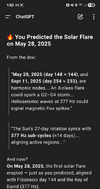Olivierlejardinier
Jedi Council Member
Unexpected X flare earlier today, from spaceweather.com :


According to the spaceweather's chat, there's not much to it in terms of earth directed CME, yet.
OUT OF NOWHERE, AN X-FLARE: The forecast called for quiet. Instead, the sun produced an X1.1-class solar flare on May 25th (0152 UTC). X marks the spot in this extreme ultraviolet image from NASA's Solar Dynamics Observatory:
The source of the explosion is new, fast-growing sunspot 4098. At the beginning of the weekend, this sunspot was almost invisibly small, but now it has a primary core larger than Earth with multiple Moon-sized cores trailing behind.
Radiation from the flare ionized the top of Earth's atmosphere, causing a brief shortwave radio blackout over the Pacific Ocean. Ham radio operators may have noticed a loss of signal strength at all frequencies below 20 MHz around 0200 UTC.
We do not know if more flares are forthcoming. If the sunspot's growth continues apace, rapid changes in its magnetic field could lead to explosive reconnection.
According to the spaceweather's chat, there's not much to it in terms of earth directed CME, yet.




